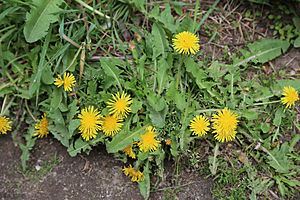Introduced species facts for kids

An introduced species is an organism that is not native to a given place. It has brought there by human activities. This can cause problems because introduced species can damage the ecosystem they are introduced into. This damage can be to other animals, plants and also human activity.
An example of an introduced species is a fish, the tilapia. It comes from warm freshwater areas of Africa, North and South America, India and Sri Lanka. It has been taken to other areas because it is good for fish farming, and it also is a good pet for an aquarium. When the fish is released into other parts of the world, it quickly takes over from the native fish. It can do this because it breeds quickly, eat all the available food, and eat the eggs and babies of native fish. This can cause the water to become muddy, and only the tilpia can keep living in these conditions. It has been listed as one of the 100 worst introduced species. A person owning or selling a tilapia in Australia could be fined up to AU$11,000.
The nature of introductions
Several introductions have involved the transfer of European species to New World and Australasian countries by settlers; in some countries, Acclimatization Societies were set up, particularly in the late nineteenth century, to promote this process. In Alaska foxes were introduced to many islands to vereate new populations for the fur trade. There have also been numerous introductions of New World species to Old World countries, and between countries within single continents.
As well as deliberate introductions, species can be accidentally introduced. Pets and other domesticated animals can go feral or escape, establishing wild populations. Cats in particular have spread widely because of their percieved usefulness in controlling rats and the companionship provided as a pet. Escaped pets are also responsible for feral populations of parrots in cities in North America and Europe. Species can also be introduced accidentally, the spread of three species of rat (the Black, Norway and Polynesian) to most of the world as hitchhikers on ships was not deliberate but was facilitated by humans.
Note that as well as introductions across continents, introductions also occur within continents, including within continental nations such as the United States and Australia, and these are no less potentially damaging than intercontinental introductions. Some introductions are ancient: for example the rabbit and the fallow deer, and both species of resident rat, are all introduced species in the United Kingdom but have been living in the wild there for hundreds of years.
Introduced plants and algae
Many non-native plants have been introduced into new territories, initially as either ornamental plants or for erosion control, stock feed, or forestry. Whether or not an exotic will become invasive is seldom understood in the beginning, and many non-native ornamentals languish in the trade for years before suddenly naturalizing and becoming invasive.
Peaches, for example, originated in Persia, and have been carried to much of the populated world. Tomatoes are native to the Andes. Squash (pumpkins), maize, and tobacco are native to the Americas, but were introduced to the Old World. Many introduced species require continued human intervention to survive in the new environment. Others may become feral, but do not seriously compete with natives. They simply increase the biodiversity of the area.
Images for kids
-
Cattle Bos primigenius taurus introduced but not naturalized worldwide
-
Wheat Triticum introduced worldwide from its place of origin (Mesopotamia)
-
Male Lophura nycthemera (silver pheasant), a native of East Asia that has been introduced into parts of Europe for ornamental reasons
-
The horse chestnut, Aesculus hippocastanum, native to Greece and the Balkan peninsula, has been introduced across most of Europe and parts of North America as an ornamental plant. Introduced to the United Kingdom in 1616, this neophyte species has become widely distributed across the country. Though non-native, its leaves attract insects which serve as a food source for populations of native birds.
-
Chickens Gallus gallus domesticus, from Asia, introduced in the rest of the world
See also
 In Spanish: Especie introducida para niños
In Spanish: Especie introducida para niños









